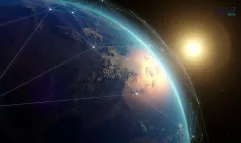IMAGIN-e Space Edge Computing demonstration payload reached the International Space Station to gather unmatched Earth observation insights

This demonstration is the keystone of an agreement between Thales Alenia Space and Microsoft to enable new capabilities in the intersection of space and cloud
An uncrewed Dragon resupply spacecraft reached the International Space Station (ISS) on March 23, delivering science investigations, supplies and equipment to its international crew. Among its precious cargo is the IMAGIN-e (ISS Mounted Accessible Global Imaging Nod-e) payload developed by Thales Alenia Space, in collaboration with Microsoft, to demonstrate and validate on-orbit compute technologies for multiple remote-sensing applications. Based on a concept shaped within the Space Business Catalyst by a Thales Alenia Space intrapreneurial team, this space edge computing capacity will allow gathering faster, to-the-point Earth observation insights immediately applicable for our planet’s surveillance, understanding and protection.
This mission marks a keystone in Thales Alenia Space plans to deliver advanced connectivity, analytics and compute in space with Space Edge Computing, in collaboration with Microsoft. The IMAGIN-e payload, which has been integrated and tested at Thales Alenia Space facilities in Madrid (Spain), features powerful on-orbit edge computing hardware running an on-orbit application framework developed by Microsoft, and a suite of visible and hyperspectral Earth observation sensors. Through Microsoft Azure Orbital SDK (software development kit), application developers will be able to easily develop and deploy Earth observation data processing applications on a real functional environment, at the crossing of space and cloud worlds.

© Thales Alenia Space
Over the next days, the IMAGIN-e payload will be prepared and installed attached to the Columbus module using a robotic arm, and will then go through a commissioning phase before entering into operations for one year (extendable to two years). Several use case applications based on Artificial Intelligence have already been identified and proposed by international application developer teams, in response to the OrbitalAI challenge launched by the European Space Agency’s Φ-lab in collaboration with Thales Alenia Space and Microsoft, in the frame of the AI4EO (Artificial Intelligence for Earth observation) initiative. The proposed areas of applications span wildfire early-detection and behavior modelling, automatic detection of objects and anomalies in ocean and maritime ecosystems (such as ships, debris, pollution, oil spills, algal blooms, sargassums, etc.), crop water stress detection, water quality monitoring, certification of space data using blockchain technology, etc.

© Thales Alenia Space
Stéphane Terranova, CEO of Thales Alenia Space in Spain, said: “the deployment of the IMAGIN-e payload on the ISS provides a fantastic opportunity to demonstrate and validate the potential of Space Edge Computing, enhanced by the power of Microsoft Azure. This opportunity unlocks new remote sensing data processing applications, for the benefit of our planet sustainability through Earth observation.”

